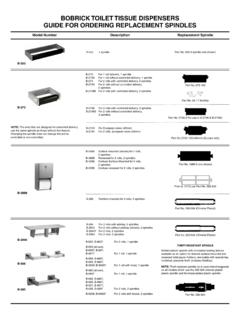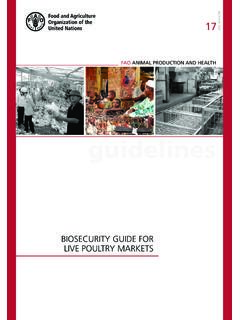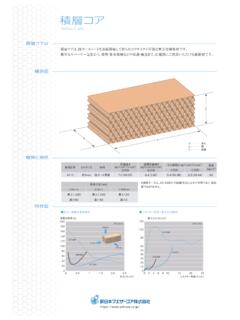Transcription of 10 Years of Research - University of Florida
1 Diffusion in Silicon10 Years of FisherSCITEC PUBLICATIONSN otes:Each item in this section of the volume begins with a graphical compilation of relevant diffusion data whichhave been reported during the past decade. The plotted data are also tabulated as indicated on the graph. In somecases, the tabulated data have been obtained by digitizing published graphs and the values may not correspondexactly with the author's unpublished raw Bulk Diffusion - Quantitative DataThe migration of Ag from epitaxial layers and into (111) samples of Si,during annealing at temperatures of between 450 and 500C, was studiedby means of secondary ion mass spectrometric depth profiling. It wasfound that the diffusivities lay between 8 x 10-16 and x 10-15cm2/s(table N). These values were lower than were expected on the basis ofprevious , , , : Journal of Applied Physics,1991, 70[3], 1392-6[446-91/92-027]Refers to table NIndicates volume and page number inDDF where abstract first appeared217 AgFigure 1: Diffusivity of Ag in Si31 Bulk Diffusion - Quantitative DataTransition metals in amorphous samples exhibit a direct interstitial diffusion behaviorwhich is retarded by temporary trapping at defects that are intrinsic to the amorphousstructure.
2 Diffusion was investigated here by means of Rutherford back-scatteringspectrometry. It was found that the data (table 1) could be fitted by using foreign-atominterstitial diffusion coefficients for crystalline Si; modified by the presence of traps inconcentrations of between and 1at%, and with trapping enthalpies of about results could be expressed as:D (cm2/s) = exp[ (eV)/kT] 1table 2104/T(K)D (cm2/s)218 AgBulk , , , , : Physical Review B, 1992,45[15], 8355-8[446-86/87-049]Table 1 Diffusivity of Ag in Amorphous SiT (C)D (cm2/s) x x x x 10-1632 Bulk Diffusion - Quantitative DataThe migration of Ag from epitaxial layers and into (111) samples of Si, during annealingat temperatures of between 450 and 500C, was studied by means of secondary ion massspectrometric depth profiling. It was found that the diffusivities lay between 8 x 10-16 x 10-15cm2/s (table 2). These values were lower than were expected on the basis ofprevious , , , : Journal of Applied Physics, 1991, 70[3],1392-6[446-91/92-027]Bulk Diffusion - Quantitative DataConcentration versus depth profiles of Ag were measured by using neutron activationanalysis and serial sectioning.
3 The Ag diffusion appeared to be very fast. In the bulk ofdislocation-free wafers, saturation was achieved after short periods of annealing. Fromthis, it was concluded that interstitial Ag was the predominant configuration in Si withoutdislocations. Equilibrium concentrations of Ag were determined for temperatures ofbetween 1287 and 1598K. The results were thermodynamically analyzed, taking accountof Ag-Si liquidus data. In dislocated Si, much higher Ag concentrations were found whichvaried irregularly with penetration depth. A comparison of the diffusion and solubility ofAg and Au in Si suggested that, in material with dislocations, substitutional Ag couldarise from Agi-Ags transitions. Finally, the Agi diffusivity was deduced to be given by:D(m2/s) = 6 x 10-5 exp[ (eV)/kT] , , : Journal of Physics D, 1987, 20[9], 1148-55[446-55/56-033]Bulk Diffusion - Qualitative Observations - Amorphous FilmsAn investigation of the diffusion and solubility of Ag in hydrogenated amorphous filmswas carried out at temperatures ranging from 290 to 525C.
4 This made it possible todetermine suitable conditions for diffusion doping. Such diffusion was used to preparehydrogenated amorphous films which were doped with this metal, and a study was made219 AgSurface DiffusionAgof their dark conductivity and photoconductivity. It was noted that diffusion doping withmetals gave rise to activation energies, for electrical conduction, which were as high That is, the activation energy exceeded 50% of the band gap; atypical behavior foran intrinsic , , , : Fizika i TekhnikaPoluprovodnikov, 1990, 24[11], 1943-7 (Soviet Physics - Semiconductors, 1990, 24[11],1208-11)[446-81/82-043]Table 2 Diffusion of Ag into (111)SiTemperature (C)Surface Concentration(/cm3)D (cm2/s) x x x x x x 10-15 Bulk Diffusion - Qualitative Observations - Effect of Surface LayerThe behavior of Ag atoms at the interface between a deposited Si layer and a Si(111)surface was studied by using a new ion-scattering spectroscopic technique.
5 During theroom temperature deposition of Si, the Ag layer was anchored at the interface betweenamorphous and crystalline Si. With increasing annealing temperature, the Ag atoms werefound to diffuse out over the adsorbed amorphous Si layer. The buried structure of thesubstrate was also reflected by the multiple scattering component of the , , , : Surface Science, 1996, 363[1-3], 156-60[446-141/142-113]Surface Diffusion - Quantitative DataMass transport on the (111) surface was studied by means of scanning electronmicroscopy and Auger analysis (with spatial resolution) under ultra-high vacuumconditions. The spreading of Ag deposits was investigated at temperatures ranging from350 to 450C; where no desorption occurred. In order to avoid electromigration, thesamples were heated by using a halogen lamp. When the first islands had formed(Stranski-Krastanov growth), Ag began to spread out of the initial deposit zone.
6 The mainfeatures deduced from the concentration profiles were that, at temperatures above about400C, the profiles exhibited a rather constant concentration that ended in a very sharpfront (attributed to an unrolling carpet mechanism). At temperatures below about 400C,the corresponding profiles had 2 gradient zones. In both cases, a t kinetic law was foundwhich suggested that Ag/Si mass transport might be controlled by the surface self-diffusion of Ag atoms, on 3-dimensional Ag islands, with an activation energy of , , : Surface Science, 1990, 239[3], 213-21[446-78/79-047]220 AgSurface DiffusionAgSurface Diffusion - Qualitative Observations - Effect of StepsThe mass transport of Ag on stepped (111) surfaces was investigated by means ofscanning Auger microscopy. Highly anisotropic surface diffusion of Ag ultra-thin filmswas observed on 0 , , 3 and 6 vicinal (111). Mass transport in a direction which wasparallel to the step edge was overwhelmingly greater than that perpendicular to the mass transport towards the cathode, due to direct current heating, was alsoobserved.
7 This increased with the resistivity of the (111) substrate. The anisotropic masstransport was related to the difference in the binding energies at the step edge sites and atthe terrace , , : Surface Science, 1991, 242[1-3], 191-4[446-81/82-043]221 AlBulk Diffusion - Quantitative DataMeasurements were made of the concentration profiles of Al atoms which had beenintroduced into p-type material by irradiation with a Nd:YAG laser in the continuouswave or Q-switched modes. It was found that limiting concentrations of Al atoms in theSi substrate were attained during irradiation under continuous wave conditions. Theconcentrations which were measured under irradiation in the Q-switched mode were up to2 orders of magnitude higher than those which resulted from continuous wave was found that the volume diffusivity could be described by:D(cm2/s) = exp[ (eV)/kT]It was also deduced that pipe diffusion occurred which could be described by:D(cm2/s) = 140 exp[ (eV)/kT] , mmel: Journal of Physics D, 1997, 30[14], 1972-5[446-152-0221]Bulk Diffusion - Qualitative Observations - Concentration ProfilesA study was reported of the vapor-phase diffusion of Al into single crystals of n-type(111) float-zone material.
8 The resultant diffusion profiles were measured by usingresistivity techniques. No specific diffusion data were presented, but qualitativeobservations were described. Thus, diffusion temperatures greater than 1150C yieldedlower surface concentrations. This was partly due to an increase in Al vapor oxidation. Atlower pressures and lower diffusion temperatures, the partial pressure increased to theextent that the surface concentration in the Si corresponded to the solid solubility of theimpurity. Under these conditions, the surface concentration was independent of the Alvapor pressure and was reproducible and uniform; even if the vapor pressure was : Journal of Materials Science Letters, 1987, 6[9], 1073-5[446-61-084]Bulk Diffusion - Qualitative Observations - Concentration ProfilesDiffusion profiles of Al were produced under rapid thermal annealing conditions. Theeffect of P upon the diffusion behavior of Al was investigated by the pre-deposition of Pinto Al-diffused wafers, and vice versa.
9 The dopant profiles were determined by meansof secondary-ion mass spectroscopy, electrochemical, capacitance-voltage and spreadingresistance methods. The profiles after Al pre-deposition at 1293K exhibited Al surface222 AlBulk DiffusionAlconcentrations which ranged up to the solid solubility limit of about 2 x 1025/m3. It wasshown that P had a marked effect upon the drive-in behavior of Al; leading to acceleratedAl diffusion ahead of the P profile (due to an enhanced Al diffusion which was caused bya supersaturation of self-interstitials) and to the up-hill migration of Al in the high-concentration regime. This was explained in terms of field-assisted diffusion. A strongretardation of Al diffusion, combined with concentrations which were well above thesolid-solubility limit, was observed during Al pre-deposition into P-diffused , , : Applied Physics A, 1995, 60[1], 61-5[446-134/135-155]Bulk Diffusion - Qualitative Observations - Concentration ProfilesThe 2-dimensional diffusion of Al that was implanted through a mask was measured afterfurnace annealing or rapid thermal annealing.
10 The chemical staining of cross-sectionedsamples was used to determine the vertical and lateral junction depths. The spreadingresistance method was also used to measure the vertical profiles, while a new procedurewas developed for the determination of the lateral diffusion profiles. Differences in theprofiles which were measured by using the staining and spreading resistance methodswere attributed to a spilling phenomenon that distorted the carrier concentration profile onbevelled , Via, , Mantia, : Journal of theElectrochemical Society, 1995, 142[5], 1585-90[446-134/135-155]Bulk Diffusion - Qualitative Observations - Doping EffectsThe electrical activity of implanted Al atoms was investigated. Precipitates of Al at thesurface did not contribute to the conductivity. Upon annealing at 1250C, the Alprecipitates disappeared. The low electrical activity of the Al atoms was related to theexistence of Al precipitates, which corresponded to O precipitates, and to the out-diffusion of Al.







